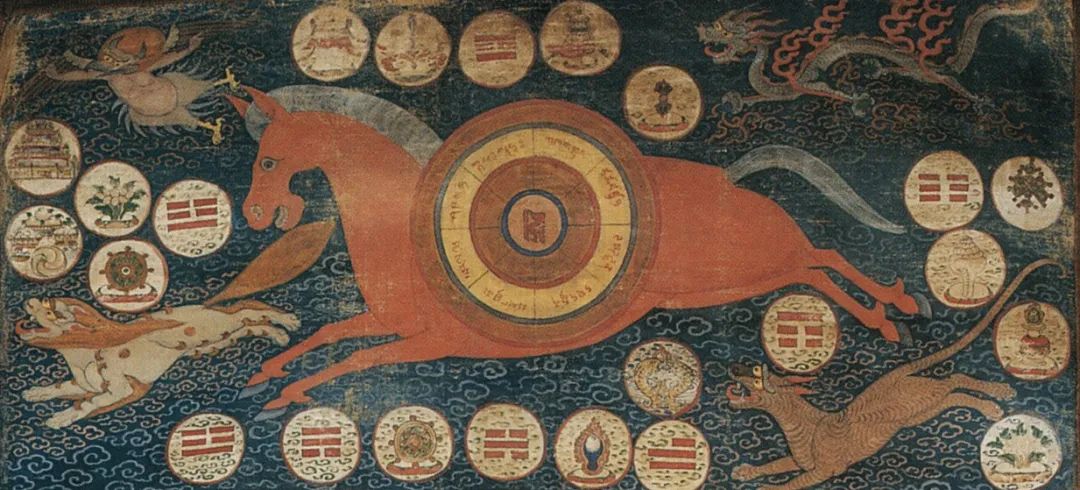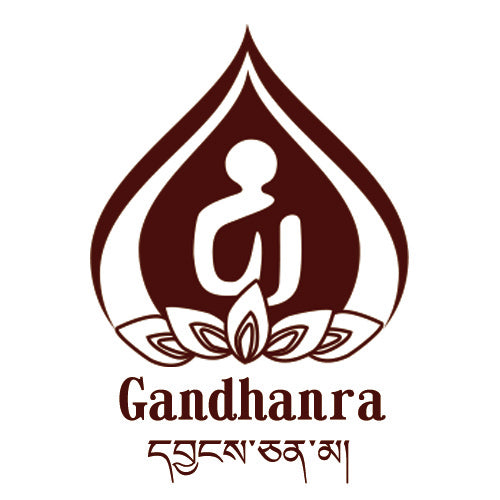
There is nothing beyond the three wheels|Key moments about the Himalayas.

"Cosmic Calculations Chart: The Three Realms of the Universe and the Gods of Heaven, Earth, and Man"
Mid-19th century, Rubin Museum collection

Partial: Three wheel symbols and the central wind horse symbol
བདག་ཅག་འཁོར་དང་བཅས་པ་ལ།
མི་མཐུན་པ་ཡི་ཕྱོགས་རྣམས་ནི།
བསྐལ་པ་མེ་ཡིས་སྲེག་པ་ལྟར།
ཐམས་ཅད་དེ་ཡི་མོད་ལ་འབྱོར།
འདོད་དོན་ཟླ་བ་རྒྱས་བཞིན་འཕེལ།
The troubles near me
are not in harmony
Disasters seem to burn out
everything is auspicious
wishes like a full moon
"Discussing the methods of appeasing disasters in Han territory"
རྒྱ་ནག་པོའི་སྐག་ཟློག་ཅེས་བྱ་བ་བཞུགས་སོ།
* In the Himalayan region, the practice of calendar calculations combines many Han Chinese calendrical concepts.
The saying goes, "Guanyin resides in the Tibetan land while Wenshu resides in the Han land of Mount Wutai.
" Wenshu Bodhisattva is considered one of the main deities of wisdom in Tibetan calendrical practices.
In the scriptures, there are many accounts of Wenshu teaching calendrical calculations in the Han Chinese land.

Local: venerable Bodhisattva Manjusri and master Gongzicujujie in calendar calculations.
About Gongzi Chuje (ཀོར་རྩེ་འཕྲུལ་རྒྱལ་), some Buddhist scholars see him as a disciple of Manjushri, the bodhisattva of wisdom, in Chinese history, such as Emperor Tang Taizong or Confucius.
Traditional Tibetan beliefs indicate that he was born on the western side of Mount Kailash and was a master of Tibetan astrology and the reason behind the tradition of respecting elders and scholars.
Looking up at the stars, surrounded by nature, people are searching for their special connection with this blue planet. In Tibetan astrology, the relationship between celestial bodies and the human body is believed to have a similar wisdom structure. The inner and outer universe is intertwined by time, and individuals must confront the seemingly complex yet fundamentally unified nature of existence. Tibetan astrology has diverse theoretical backgrounds, but its main components can be broadly categorized into elemental astrology (འབྱུང་རྩིས་) and astrological horoscopy (སྐར་རྩིས་). The former focuses on the unity of the body and the universe in terms of their constituent elements, while the latter focuses on their unity in the realm of time and space.
It should be noted that the concept of "body" here includes not only the physical body, but also the individual's prosperity and fortune. In a classic classification, Tibetan scholars from ancient times associated the results of divination with fate (སྲོག་), body (ལུས་), fate's power (དབང་ཐང་; including wealth, harvest, descendants' blessings, and other related objects extended from oneself), and fortune (ཀླུང་རྟ་/རླུང་རྟ་; often mistakenly translated as wind horse in visual representation). This is also one of the reasons why divination was considered a form of "healing art" in classical times.
In order to receive blessings stemming from the wisdom of ancient calculations, people choose to depict the visible and hidden universe on canvas. When we see it, show it to others, or possess it, the unpredictable future gains the right guidance, and everything that is happening is also presented in its original form. "Prediction" has never been considered to have certainty, and that voice is full of warning. Sangye Gyatso Tenzin (1912-1978), a prominent figure in the 20th century Ben religion, once admitted, "There is nothing beyond the three wheels," as evidenced by the various historical calculation charts stored in the Rubin Museum, where the three wheels of the universe are fully revealed. A kind of natural law declaration constantly enters the ears of the viewers from the images: you can choose to ignore it, but you are still within the three wheels.

《Calendrical Chart: Cosmic Cycles and Various Deities of Heaven, Earth, and Humanity》
Late 19th century, Rubin Museum of Art collection

"Chart of History: The Three Realms of the Universe and the Various Gods of Heaven, Earth, and Humanity"
Late 19th century, Collection of the Rubin Museum
Detail: Power of destiny flourishing in agricultural and business sectors.

"Diagram of Destiny: The Celestial Triad and Various Deities of Heaven, Earth, and Humanity"
Late 19th century, Rubin Museum Collection
Detail: The flourishing of power and authority in pastoral endeavors
The so-called "three wheels of the universe" include the "wheel of the sky god", the "wheel of the airborne spirits", and the "wheel of the earth turtle". From the sky to the air, and then to the earth; people live in the midst of these wheels without knowing that they are being protected by them. From the various gods of different origins to the spirits in our world, and to the various earth deities surrounding the golden turtle, as part of the law, people's bodies and minds undergo subtle changes due to the influence of these three wheels.
It is important to note that the "Nian" in "Air Nien Wheel" can not only refer to a specific supernatural creature, but they often play the role of creators and maintainers of the earthly power order and the ethics of our lives. The well-known mountain god Nianqing Tanggula belongs to this purely local ideological system (occupying the center in the local cosmology). Similarly, the term "Nian" can also refer to all spiritual beings that roam between heaven and earth. We often mistakenly see them as enemies, not realizing that they have always been following rules and harmonizing different fundamental forces. The consequences of violating them are dreadful, and all of this can still be revealed in the calculations.
In the "Cosmic Triad", we not only can understand the significance of Tibetan astrology, but its unique arrangement structure also provides an interesting interpretation of the developmental history of Tibetan astrology from a visual perspective. Firstly, the "Cosmic Triad" belongs to the Buddhist-style indigenous cosmology, and some scholars tend to associate it with the "Mount Meru Universe" or the "Three Realms". In some astrological images, the "Cosmic Triad" is depicted as a palace in the shape of a mountain, with each of the three levels featuring a distinctive character. Secondly, the "Cosmic Triad" represents South Asian astrology, indigenous astrology, and East Asian astrology, each symbolized by the deities of South Asia, the spirits of the indigenous people, and the golden turtle of East Asia to present their respective mathematical concepts.
In the "Three Wheels of the Universe," the boundary between the sky and the earth is marked by the image of "Ten Paramitas" (རྣམ་བཅུ་དབང་ལྡན་), which is the embodiment of the body, speech, and mind of the Wheel of Time Vajra. With the formal introduction of the Wheel of Time calendar into Tibet in the eleventh century, this system gradually became the core of Tibetan calendrical calculations. The power of this "Three Wheels of the Universe" is so great that people have to seek help from complex calculations and strategies. Fortunately, in the narrow space that belongs to the human realm, we can still see a horse symbolizing harmonious auspiciousness (a classic case of conceptual imagery in Tibetan culture), through its cyclic movements, our reputation (སྙན་གྲགས་), power (མཐུ་སྟོབས་), skills (དཔའ་རྩལ་), and influence (ཟིལ་གནོན་) are blessed eternally.

"Oracular Diagram: The Earth Wheel and Wind Horses"
Mid-18th Century, image from "Tibetan Art at Spink"
Detail: Symbolic image of wind horses representing fortune.

